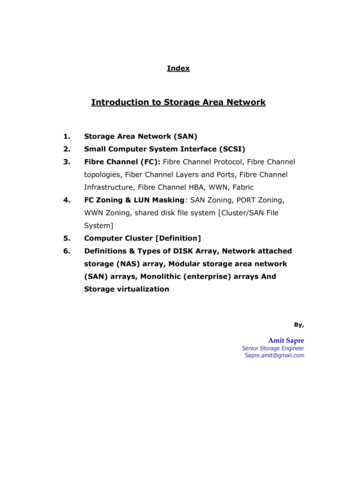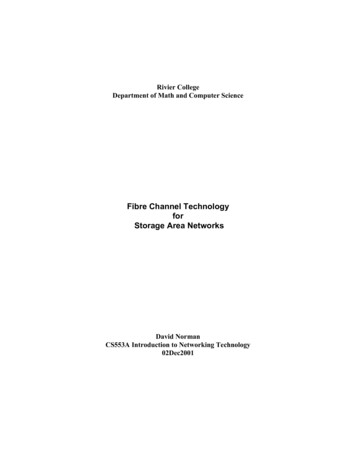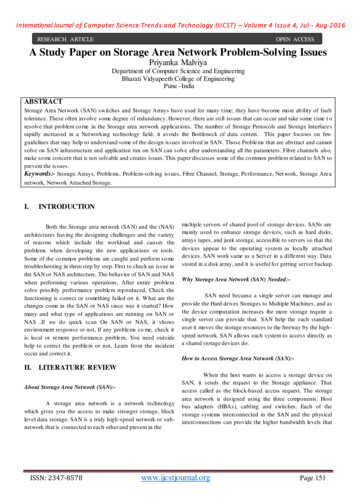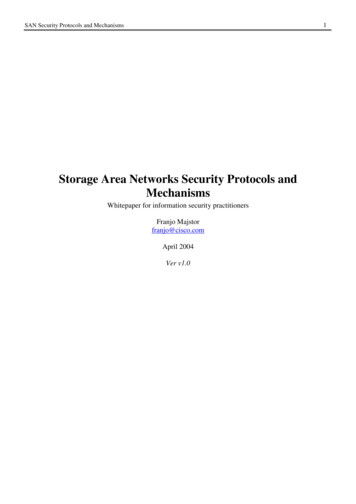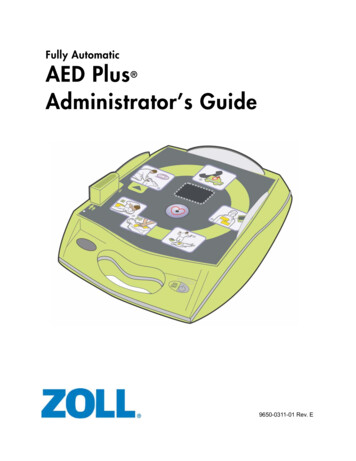
Transcription
Conference on File and Storage Technologies (FAST’02), pp. 203–217,28–30 January 2002, Monterey, CA. (USENIX, Berkeley, CA.)Appia: automatic storage area network fabric designJulie Ward, Michael O’Sullivany, Troy Shahoumian, and John WilkesHewlett-Packard Laboratories, Palo Alto, CA and y Stanford University, Stanford, CAjward@hp.com, mosu@stanford.edu, troy shahoumian@hp.com, john wilkes@hp.comAbstractDesigning a storage area network (SAN) fabric requiresdevising a set of hubs, switches and links to connect hoststo their storage devices. The network must be capableof simultaneously meeting specified data flow requirements between multiple host-device pairs, and it mustdo so cost-effectively, since large-scale SAN fabrics cancost millions of dollars. Given that the number of dataflows can easily number in the hundreds, simple overprovisioned manual designs are often not attractive: theycan cost significantly more than they need to, may notmeet the performance needs, may expend valuable resources in the wrong places, and are subject to the usualsources of human error.Producing SAN fabric designs automatically can address these difficulties, but it is a non-trivial problem: itextends the NP-hard minimum-cost fixed-charge multicommodity network flow problem to include degree constraints, node capacities, node costs, unsplittable flows,and other requirements. Nonetheless, we present heretwo efficient algorithms for automatic SAN design. Weshow that these produce cost-effective SAN designs invery reasonable running times, and explore how the twoalgorithms behave over a range of design problems.1 IntroductionA SAN (storage area network) connects a group ofservers (or hosts) to their shared storage devices (such asdisks, disk arrays and tape drives) through an interconnection fabric consisting of hubs, switches and links. Wepresent results for designs using today’s dominant SANfabric for the SCSI block-level protocol, FibreChannel[13]. The storage industry is in the process of addingswitched Ethernet as an alternative block-level networktransport. We believe that our work applies equally toboth, and could also usefully be applied to file-basedstorage systems, and even general-purpose local-areanetworks (LANs).An example FibreChannel SAN is shown in Figure 1.SANs offer many advantages over direct-connected local storage, including superior connectivity of servers toFigure 1: A simple, single-layer SAN fabric. Hosts appear inthe top row, devices in the bottom row, and switches and hubsin between.storage devices, better utilization of storage resources,centralized administration and management, increasedscalability, and improved performance. In spite of theseadvantages, the adoption of SANs has been relativelyslow. Some of this is due to interoperability difficulties between vendors, but as these are being resolved,the next barrier appears to be the complexities associated with designing the SANs, because this involves allof the problems of network design – in an environmentwith essentially no automatic flow control, and zero tolerance for packet loss, due to the low-level nature of theSCSI protocol.As a result, designing even small SANs requires considerable time and effort from IT experts. Their manual methods often result in expensive, overprovisioneddesigns – and this becomes more of a problem as the designs get larger and more complex. This matters: it is notdifficult to spend 10–20% of the total storage system coston the SAN fabric elements, and SAN designs of a scalethat require an investment of millions of dollars in theSAN fabric alone are becoming more common. We havewitnessed a factor of three difference in the cost of a SANbetween a manual design ( 4m) that took several daysand an automatically-generated one ( 1.4m) that took afew minutes.Design mistakes can be subtle and therefore easy to overlook, yet potentially very costly; poor performance iscommonplace, and downtime in failure situations can result if the fault-tolerance aspects are mis-designed. AsSANs grow to include hundreds or even thousands of
storage devices, it becomes increasingly difficult, evenfor SAN experts, to manually design cost-effective andreliable SANs.We believe that the most effective approach to theseproblems is to automate the design of SANs. Such designs must take into account the performance demands(to avoid queuing or packet loss), and they should tryto minimize system cost, because SAN components arequite expensive. The result would enable the wider deployment of SANs, as well as increase the likelihood thatthe systems deployed would meet real needs.This paper presents just such a solution: a tool to design SANs automatically. We call it Appia, after the Appian Way, one of the network of roads leading to ancientRome.1.1Automated design of storage systemsAppia was developed to operate in concert with a set oftools that select and design the storage-device portions ofa complete storage system [2, 4]. These tools use workload and device performance information to select andconfigure storage devices, and then determine appropriate data placements on those devices. Their goal is todesign a system that meets performance goals with highreliability at low cost. A side effect is that the tools’ output includes information about the workload data-flowsfrom each host to each storage device: precisely the information that is needed to design the SAN fabric to connect the hosts to their storage.Such tools significantly reduce the human interventionrequired to design storage systems: people can expresstheir needs at a relatively high level, and the tools candesign a storage system to meet their needs, taking intoaccount all the low-level details, such as predicting thecomplex performance effects that result from mixingworkloads on shared storage devices. Better yet, suchtools can be used in an automatic control loop, allowingthe storage system design to evolve completely automatically when dealing with load and system changes, without the need for human intervention.We wanted to achieve the same benefits for SAN design. The results presented here are the first outcomeof that goal. In particular, we present two algorithms forcost-effective SAN fabric design. These two approaches,which we call FlowMerge and QuickBuilder, demonstrate complementary strengths. FlowMerge, which ismore computationally intensive, tends to find lower-costdesigns for SANs with sparse connectivity requirements,whereas QuickBuilder excels when connectivity requirements are dense. We found that the better of two designsis, on average, within 33% of the optimal design cost forempirical test problems that are small enough to solveoptimally. Moreover, these designs are found in a fewminutes or less for SANs with 50 hosts and 100 devices,a size typical of the largest current installations. Becauseof their complementary strengths, both algorithms are included in Appia.1.2Structure of the paperThe remainder of this paper is organized as follows. Section 2 presents a statement of the SAN fabric designproblem, including notation and related work. Section3 presents an overview of the FlowMerge algorithm forfinding cost-effective SAN fabric designs. The QuickBuilder algorithm is presented in x4. In x5 we presentcomputational results comparing the effectiveness of thetwo algorithms. Furthermore, for small problems wecompare the cost of designs produced by FlowMerge andQuickBuilder with the cost of optimal designs. Futurework and conclusions are presented in x6 and x7.2 The SAN design problemThe SAN design problem can be stated quite simply: weare given a set of hosts, a set of storage devices, and a setof requirements in the form of data flows between hostdevice pairs. Each flow has a desired bandwidth. Thegoal is to build a minimum-cost SAN to support all ofthese requirements simultaneously. To do so, one mustselect a set of fabric nodes (switches and hubs), a set oflinks connecting pairs of nodes (hosts, devices and fabricnodes), a topology with which to join these together, anda single path through the network for each flow. (Thesingle-path restriction arises from SCSI request-orderingconstraints.)The resulting fabric design must be feasible - that is, itmust satisfy constraints that ensure it is buildable, andit must support the connection and performance requirements. These constraints are: (1) the number of linksconnected to a host, device or fabric node must not exceed the number of ports available there (these restrictions are called degree constraints) and (2) the flow routing must honor the bandwidth limitations of links andfabric nodes. Because packets travel differently throughhubs and switches, their bandwidth constraints differ.Packets routed into a switch are forwarded directly tothe next destination in their path. In contrast, packetsrouted into a hub are transmitted through all connectedhubs and all links attached to these hubs; they are seizedby their next destination. Thus, the total flow into an interconnected set of hubs is limited by the minimum of thebandwidth of each individual hub, the bandwidth of eachconnected link, and the bandwidth of each port used bythese links. The bandwidth of switches is therefore moreefficiently utilized than hub bandwidth.
Data about the flows is readily available from solutionsto the storage-system and data-placement design problems [2, 4], but it may also be obtained from the triedand true techniques of measurement of an existing system or estimation. Obviously, no design tool is betterthan the inputs it is given – but the comparison pointhere is manual design, not complete knowledge of thesystem’s future behavior. It is easy enough to build in acertain amount of “slack”, to allow for errors, or anticipated future growth. Indeed, we believe that it is betterto have the slack specified up front as part of the goal,so that the design system can take it into account, ratherthan trying to build in slack “after the fact” by adding excess SAN elements in places where they may not do themost good.The design algorithms we describe run fast enough thatthey can be used in interactive “what if” scenario exploration, in conjunction with manual input from a SANdesign expert. The low-cost designs the tools producemay not always “look pretty”; some people prefer greatersymmetry in their solutions, even at the expense ofgreater cost. As such, we believe it is important to usethis kind of tool – at least at first – in a context wherethere is a chance for experts to modify the output it produces. Nonetheless, it is our aim to develop tools that canbe placed into a completely automatic design-deploymonitor-redesign loop.2.1Related workSAN design is currently done manually by IT experts,who use error-prone ad-hoc methods or canned topologies that often result in grossly overprovisioned designs.While overprovisioning can be advantageous, it is important that it is done strategically to provide high performance, scalability, reliability, and robustness to changesin requirements. Some canned designs currently in use,such as the Brocade Core-Edge architecture [9], possessthese characteristics. They are used when the SAN designers have no systematic way to predict the connectivity and data flow requirements in their SANs, and soopt for full connectivity between hosts and devices. Butthis flexibility comes at a very high price: many fabricelements are needed to provide this connectivity, especially at high bandwidths. In general, when any information is available about SAN requirements, far morecost-effective designs can be found.As part of our search for algorithms to apply to this problem, we turned to the literature on network design. Unfortunately, most traditional network design approachesonly address link costs, because switches are cheaperthan trenching in wide area telephone networks, whichare the target of most of this work. In the SAN case, thereverse is usually the case: in mid-2001, a fully loaded64-port FibreChannel “storage director” (a high-end fabric switch) costs close to half a million dollars, while individual fibre links for use within a data center are pricedaround 100– 500. As a result, much of the existing research in network design proved less applicable than wehad hoped.In particular, the SAN fabric design problem generalizesand extends several NP-hard problems in network design. For example, it generalizes the nonbifurcated network loading problem [21, 6, 3, 16, 17]. In this problem,there are several commodities, each with an origin anddestination node in the network, and a required amountof the commodity that must travel through the networkbetween these nodes. One must choose a minimum costset of capacitated links connecting a known set of nodesto satisfy these flow requirements simultaneously. Theterm “nonbifurcated” refers to the requirement that a single route for each commodity must be selected; i.e., flowscannot be split across multiple paths. Each link has anassociated fixed cost, and multiple links between a givenpair of nodes may be selected. This problem containsthe Steiner tree problem, known to be NP-complete, inwhich one must find the minimum cost set of links toconnect a given subset of the nodes in a network. (See[23] for a survey of work on the Steiner tree problem.)The nonbifurcated network loading problem is NP-hardeven when all commodities share a single source [21].If we relax the constraint that flows cannot be split, theSAN design problem generalizes the multicommoditynetwork design problem [20, 8, 7, 19, 22, 10, 5]. Thisproblem is known to be NP-hard even in the single commodity case [15]. Like the nonbifurcated network loading problem, it involves choosing a set of capacitated,fixed-cost links to connect a set of nodes to satisfy multicommodity flow requirements. Any number of links between a pair of nodes can be selected. In this case, however, flows can be split. Even so, multicommodity network design problems are notoriously difficult to solve inpractice. This is true because their integer programmingformulations’ LP relaxations do not provide tight lowerbounds. Even finding feasible solutions is often difficult.Surveys of work in this area are given in [18, 1, 24].In the NP-hard problems mentioned above, one must finda minimum cost set of links to route the flows, when thenodes in the network are known. The SAN fabric designproblem generalizes these problems, in that the nodes inthe network are not known a priori. One must choose aset of hubs and switches with which to build the interconnection fabric between hosts and devices. Several different types of hubs and switches may be available, differing in attributes such as cost, bandwidth, and number ofavailable ports; an arbitrary number of instances of eachtype may be used in the SAN. It is possible, however, to
construct a candidate fabric node set containing the optimal set. Few authors have considered network designproblems in which the topology is unknown. The Steinertree problem is a special case of the capacitated networkdesign problem in which some nodes may optionally beexcluded from the network. The integer programmingformulation of network design problems grows in dimension exponentially with the size of the set of nodes considered, and thus it is essential to find a small candidatenode set. Unfortunately in the SAN design context it maybe difficult to determine such a candidate set of reasonable size due to the number of different node types considered.SAN design also generalizes other network design problems by associating capacity and cost with nodes. [17]includes node costs, and [27, 14] consider node capacities. A node’s cost and capacity can be handled withinthe context of standard network design problems at theexpense of an additional node and arc: each capacitatedor cost-inducing node can be replaced by two uncapacitated and costless nodes with an arc between them possessing the original node’s cost and capacity attributes.(This assumes unidirectional links, which will not alwaysbe the case in future SAN design problems.)Another confounding feature of the SAN design problemis the presence of degree constraints on nodes. Degreeconstraints appear only in special cases of the networkdesign problem such as the degree-constrained minimumspanning tree problem [12, 11, 25], known to be NP-hard[15].may differ in cost. Finally, fabric node type n 2 N hascost cn and maximum aggregate bandwidth bn . The SANfabric design problem defined by given sets of hosts, devices, flows and nodes is denoted by P .3 The FlowMerge algorithmThe first of our algorithms is called FlowMerge, whichearns its name from the way it pulls together separateflows into sets of flows that share fabric nodes. It wasinspired by this simple fact: when two flows with a common host or device are routed together through a link,they conserve a port on that host or device. FlowMergeattempts to use fabric nodes in a way that alleviates ashortage of host and device ports, by selecting subsetsof flows with common hosts or devices to route togetherthrough links.FlowMerge is a recursive algorithm that creates a SANdesign by introducing, at each recursive application, aset of fabric nodes and links, with no links between fabric nodes in the set. When the algorithm terminates, thefabric design consists of one or more “layers” of nodes,where there are links between but not within layers. Anexample of a layered fabric produced by FlowMerge isshown in Figure 2. The top and bottom rows of components contain hosts and devices, respectively, and theremaining components are fabric nodes.The many features of the SAN design problem have beenaddressed individually or in small subsets in the workmentioned above. The first to address all of its featuresin a common framework was [26], in which an algorithmcalled Merge was presented. Merge found cost-effectivedesigns for small problems but failed to find feasible designs for larger problems. The algorithms presented hereare proven to find feasible designs under a reasonable setof conditions, and their designs are generally more costeffective.2.2NotationSome notation will be useful in describing our approaches. Let H and D represent the sets of hosts anddevices, respectively. Denote the set of flows by F . LetN be the set of all types of switches and hubs available.Each component i 2 H[D[N has a maximum numberof ports pi , each with cost i . Although a SAN couldbe built from several different types of links differing inbandwidth and cost, we restrict attention in this paperto the case when there is one available link type whosebandwidth is and cost is . To simplify exposition, wealso assume that all ports have bandwidth , though portsFigure 2: A sample SAN fabric produced by FlowMergeThe basic building block of a FlowMerge fabric is asingle-layer fabric. This is a fabric that has no linksbetween fabric nodes, so that each flow requirement isrouted either along a direct link between its host and device, or along a two-link path that passes through a singlefabric node. Figure 1 depicts an example of a singlelayer fabric. In x3.1 we describe the procedure that introduces a single layer of nodes, which we call SingleLayer FlowMerge. In x3.2 we outline the recursive procedure that creates a multi-layered fabric through successive calls to Single-Layer FlowMerge.
3.1Single-Layer FlowMergeThe input to Single-Layer FlowMerge is a set H of hosts,a set D of devices, and flow requirements F betweenthem. Single-Layer FlowMerge produces a series ofsingle-layer fabric designs to support the flow requirements. Each design in the series is feasible with respectto all except, possibly, the degree constraints on hostsand devices. The initial design consists of a direct hostdevice link for each flow. This design is typically infeasible because one or more hosts or devices has fewer portsthan incident links. The difference between the numbersof incident links and available ports on a given host or device is called its port violation. Each subsequent designin the series has a smaller total port violation than theprevious design, or a lower cost than the previous designif both designs are feasible.To see how this series of designs is obtained, consider anarbitrary single-layer fabric. Associated with each fabricnode in the design is a subset of flow requirements routedvia that node. Similarly, associated with each direct hostdevice link in the fabric is a subset of flows routed alongthat link. In general, the flow requirements are partionedinto disjoint subsets, such that each flow requirement isin exactly one subset. Each subset in the partition has anassociated fabric node or direct host-device link throughwhich all flows in the subset are routed. We call thesesubsets flowsets.Single-Layer FlowMerge begins with the finest partitionof the flow requirements: each flow is in its own flowset.At each iteration, a new, coarser, partition is obtainedby merging two flowsets together. When merging twoflowsets, we must select a fabric node type among available types with which to route the flows in the mergedflowset, and the links connecting hosts and devices to thenode along which we route the flows. The node type isselected based on the number of ports available on thenode and the cost of using the node (including the costof required ports and links). We select the flowsets tomerge to alleviate port violations, favoring reductions onthe hosts and devices with the most severe violations.Cost is a tie-breaker criterion. Once two flowsets aremerged, they are never split. Single-Layer FlowMergecontinues merging flowsets until either no two flowsetscan be merged, or all port violations have been eliminated and no merger produces a cost savings. SingleLayer FlowMerge terminates, because after a finite number of mergers (one less than the number of flows) onlya single flowset remains, so no further mergers are possible. Figure 3 demonstrates how Single-Layer FlowMergeworks on a small example.Pseudocode for the Single-Layer FlowMerge algorithmis shown in Figure 4. We use the following notation:Figure 3: Example application of Single-Layer FlowMerge.The problem has 3 hosts and 3 devices, each with 2 ports, anda single type of switch available with 8 ports. The eight flowsin the problem each have bandwidth 33 MB/s. Links and portshave bandwidth 100 MB/s. Six successive designs are shown,beginning with the one that assigns each flow to its own link. Ineach design, hosts and devices with the highest port violationare circled. For example, in the first design, the highest portviolation is one: there are two hosts and two devices each withthree incident links and only two ports. Each design in theseries reduces the port violation on one host or device fromthe previous design by merging two flowsets together. Afterfour mergers, all port violations are eliminated. The last mergeeliminates one fabric node and thereby reduces the cost of thefabric. F is the partition of the set of flows F into flowsets(more explicitly, F is a collection fJ : J Fg withthe property that [J 2F J F and K \ J ; for allJ;K 2 F, J 6 K ); N is the set of available fabric node types; l is the single available link type; M f(J;K;n) : J;K 2 F;J 6 K;n 2 N [ flggis a set of triples consisting of two flowsets and onenode type or link; scorem is a function defined on elements of M.We refer to elements of M as mergers because they represent the combinations of flowset pairs and node typesthat are candidates for merging.In the Single-Layer FlowMerge psuedocode, each application of the outer loop results in a merger. We start anapplication of this loop by initializing the set of candidate mergers M to be all possible flowset pair-node combinations, and then eliminating infeasible combinations.Next, we compute the port violations on hosts and devices. If there are candidate mergers left to consider, werefine this set in the inner “Else while” loop. This loopconsiders port violation degree ranging from the currentworst, v , down to 1. For each such degree, it “scores”
each merger in M by counting the number of hosts anddevices with that degree port violation on which it conserves ports. After scores are computed, mergers that donot achieve the highest score for this degree are removedfrom consideration. If multiple candidate mergers stillremain, it eliminates all but those with the lowest cost.After the inner loop is finished, a single merger from thecandidate set is then implemented. Since we are indifferent between all candidate mergers at this stage, we couldintroduce randomization into the algorithm in the selection of the merger from the final set of candidates.Scores computed in the inner loop can be largely reusedin successive applications of the outer loop. In our implementation, they are updated for flowset pairs containinghosts or devices whose port violation was reduced in theprior merger.3.2Multi-Layer FlowMergeWhen Single-Layer FlowMerge is applied to a SAN fabric design problem, it will reduce at least one host’s ordevice’s port violation by at least one. (We omit the details of this proof in the interest of brevity.) However,Single-Layer FlowMerge may not successfully eliminateall port violations on hosts and devices. In this case, itis reapplied recursively to generate cascading layers offabric nodes. Pseudocode for this recursive application,which we call Multi-Layer FlowMerge, is shown in Figure 5.Single-Layer FlowMergeInput: a SAN fabric design problem P .Output: a set of flowsets F and a fabricnode for each flowset.Let F f : f.While (true)Let (J;K;n) : J;K F;J K;nl .Remove fromall elements thatrepresent infeasible mergers.Compute the port violation on eachsource and terminal with respect tothe current set of flowsets and theirassociated nodes and link. Let v bethe highest port violation among them.If , break.Else while (v 0) and ( 1)For each mLet scorem 0.For each source and terminal cwith port violation vIf merger m reduces the portviolation on cLet scorem scorem 1.which didRemove elements ofnot achieve the highest score.Let v v 1.ff g 2 FgfM fMM ;62 N [f ggjMj2M ffMgThe central idea behind the recursion is as follows. Wefirst apply Single-Layer FlowMerge to a SAN fabric design problem P . If all host and device port violations areeliminated from P , we have found a feasible SAN fabric design. At this point, we can stop, since Single-LayerFlowMerge found no cost-saving mergers and introducing new fabric nodes would only increase costs.If instead there are remaining host and/or device port violations, the current set of fabric nodes is insufficient.We address the host port violations first, independentlyof the device port violations, by recasting the problem asa new SAN fabric design problem PH that has only hostport violations and no device port violations. The hostsof P become hosts of PH . Subsets of flows in problem Pare aggregated together to become flows for problem PHaccording to their assignment to links in the one-layer solution to P . More specifically, for each flowset and eachlink into the flowset’s fabric node, a new flow is createdin PH whose bandwidth is the aggregate bandwidth offlows assigned to that link. The new flow’s device in PHis the fabric node itself. If instead its flowset has no fabric node (and thus has a single direct link between a hostand device), all flows routed along that link are aggregated into a single flow in PH . For this flow we create a“dummy” device in PH with a single port that costs the2,m2MFor eachCompute the cost of merger m.which did notRemove mergers inachieve the lowest cost.Mg2M K; nReturn a random m (J; ).If the merger m reduces the portviolation on at least one sourceor terminal with a positive portviolation, or if the merger has anegative cost, perform the merger: and K from F, discardingdelete Jtheir respective nodes, and replace with a new flowset JK with a node oftype n.Otherwise, break.[gReturn flowsets in F and their associatedfabric nodes.Figure 4: Single-Layer FlowMerge
Multi-Layer FlowMerge(P;L)Input: a SAN fabric design problem P and alayer number L.Output: a feasible SAN fabric designconsisting of one or more layers of fabricnodes, with no links between nodes in a givenlayer.Apply Single-Layer FlowMerge to P .If there are remaining host portviolations in current solution to PRecast problem as new Multi-LayerFlowMerge problem PH .Apply Multi-Layer FlowMerge(PH ;L 1).Add fabric for PH to fabric for P .f,gIf there are remaining device portviolations in current solution to PRecast problem as new Multi-LayerFlowMerge problem PD .Apply Multi-Layer FlowMerge(PD ;L 1).Add fabric PD to fabric for P .fgIf there are no remaining port violationsin PReturn fabric for P .Figure 5: Multi-Layer FlowMergesame as its original device’s ports. Thus, the set of devices in PH consists of fabric nodes from P and dummydevices corresponding to devices from P ; none of thesehave port violations.We then apply Multi-Layer FlowMerge to the PH andcreate a multi-layered fabric for that problem. The nextstep is to incorporate the fabric for PH into the solutionwe are building up for P . PH ’s fabric layers are insertedinto the fabric of P .Similarly, if device port violations remain in P afterthe application of Single-Layer FlowMerge, then a newproblem PD is created in a way that mirrors the creationof PH . It has all devices from P as its devices, aggregated flows from P as its flows, and hosts consisting offabric nodes and dummy hosts corresponding to hosts inP: PD is solved and its fabric is incorporated into P ’ssolution.In this brief overview of Multi-Layer FlowMerge, wehave omitted many details. For example, there are special precautions taken which ensure that there are nolinks between hubs in the fabric. While this is not strictlynecessary, it is the most efficient way to ensure that hubcapacity constraints a
Designing a storage area network (SAN) fabric requires devisinga set ofhubs,switchesandlinkstoconnecthosts to their storage devices. The network must be capable of simultaneously meeting specified data flow require-ments between multiple host-device pairs, and it must do so cost-effectively, since large-scale SAN fabrics can cost millions of .

